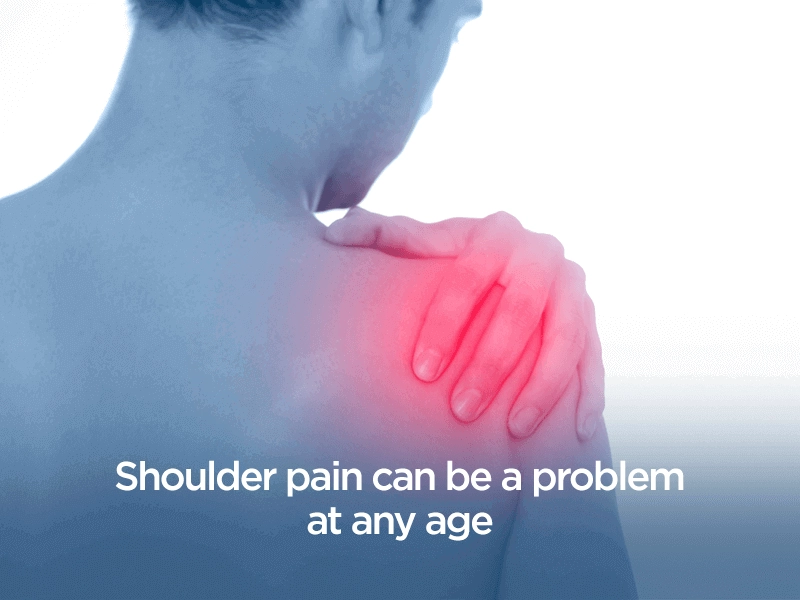Home/Wellness Zone/Sakra Blogs
8th Mar, 2016

The shoulder is a complex ball and socket joint that is able to move in many directions. With this great mobility comes a lack of stability. This lack of stability in the shoulder makes it susceptible to injury and pain. Pain is the most common complaint among patients with shoulder problems. Not only are there several structures within and surrounding the shoulder joint which cause pain, but there are various clinical conditions that can be a cause too. So, to a laymen pain is the only thing on the cause to their shoulder pain can be due to a couple of pathological conditions. Finding the cause of your shoulder pain is one of the most important things that your doctor can do. This will help you treat your pain and help you prevent it in the future.
Pain in the shoulder joint can be a manifestation of problems within the shoulder joint or a problem with the tissues surrounding the shoulder, but in rare cases it may-be a referred pain due to structures away from the shoulder like cervical spine, heart, lung and diaphragm. So it is very important for the treating doctor to localise the cause for pain.
Common causes of shoulder pain include:
1. Poor posture: Poor posture in sitting or standing can cause shoulder pain. If you have a rounded shoulder posture, the shoulder joint is placed in a position where the bursa, muscles, and tendons in the shoulder can be pinched.
You can try this exercise on your own - sit with a poor posture (hunched back and let your shoulders sag forward) and try to lift your arms up overhead. They probably will not go very far, and the strain will be felt on the shoulders. Now sit with a good posture (back upright with the shoulder blades pulled back) and raise your arms again, you will find that the arms can reach fully overhead with no strain.
2. Repetitive overhead activity: While reaching overhead, the space between the shoulder tendon and the shoulder blade decreases. The tendons can then get pinched underneath the bony part of the shoulder blade. This pinching, often called impingement syndrome, can be painful.
Chronic shoulder pain often stems from prolonged, repetitive, or awkward movements. This type of pain is sometimes referred to as repetitive strain injury (RSI) or cumulative trauma disorder. This is common among people who work with their arm above the shoulder level, like housewives, teachers, painters, carpenters and sports men. Sports like shooting a racket in badminton, overhead throwing, etc. will lead to repetitive strain on one group of muscles. Which eventually lead to fraying of those muscles and may cause tear with minor trauma and rarely without trauma also.
3. Trauma: Occasionally, trauma can cause shoulder pain. Falling on an outstretched arm or falling on the side of your arm, fall from two-wheelers, sudden jerky movements while trying to avoid falling, all can lead to sudden injury and can break the bones or injure the tendons and/or ligaments of the shoulder. It can also can dislocate the shoulder resulting in shoulder pain.
4. Natural aging or degeneration: Common degenerative conditions are degenerative rotator cuff disease, which involves tendinitis and tear, other common condition is arthritis of shoulder joint which affects the elderly and is one of the most painful condition.
Arthritis is a degenerative condition that causes inflammation in any of the joint in the body. It most often occurs in the weight-bearing joints of the body, like the hip and knee. Occasionally, arthritis can occur in the shoulder, causing severe pain and loss of motion.
5. Medical illness – Patients with conditions like Diabetes, Hypothyroidism, Rheumatoid Arthritis, Peripheral Neuropathy will have more affections in shoulder joints. Diabetes commonly affects the shoulder joint in multiple ways, Adhesive capsulitis or frozen shoulder is the most common shoulder ailment in diabetes. It has been reported in 19% of diabetic patients, usually more severe in the dominant shoulder. This term refers to a stiffened glenohumeral joint usually caused by contraction of the joint capsule.
Characterized by pain and severe limitation of movements of the shoulder joint, particularly external rotation. Other features include pain while putting on a sweater or T-shirt, difficulty in reaching the back for cleaning and scratching. Inflammatory conditions like Rheumatoid Arthritis will cause muscle tendon inflammation of the rotator cuff and biceps and also can cause hypertrophy and inflammation of the sub-acromial bursa both of which are very painful conditions.
6. No apparent reason (idiopathic): Often, shoulder pain occurs for no known reason. If this happens, one must rule out a repetitive strain that occurs with overhead reaching or poor posture as the cause. Adhesive capsulitis and calcific tendinitis can affect the shoulder without any obvious cause.
Very often, shoulder pain is accompanied by loss of motion or weakness in the muscles that support and move the shoulder. Your doctor can evaluate your shoulder pain to help initiate the correct course of treatment. He/she may also order tests, like X-rays or an MRI, to help diagnose your problem.
When shoulder pain occurs, it is important to work with your doctor and physical therapist to help determine the cause of the pain. This can help direct treatment to ensure rapid recovery and a full return to normal activity
Enquire Now
